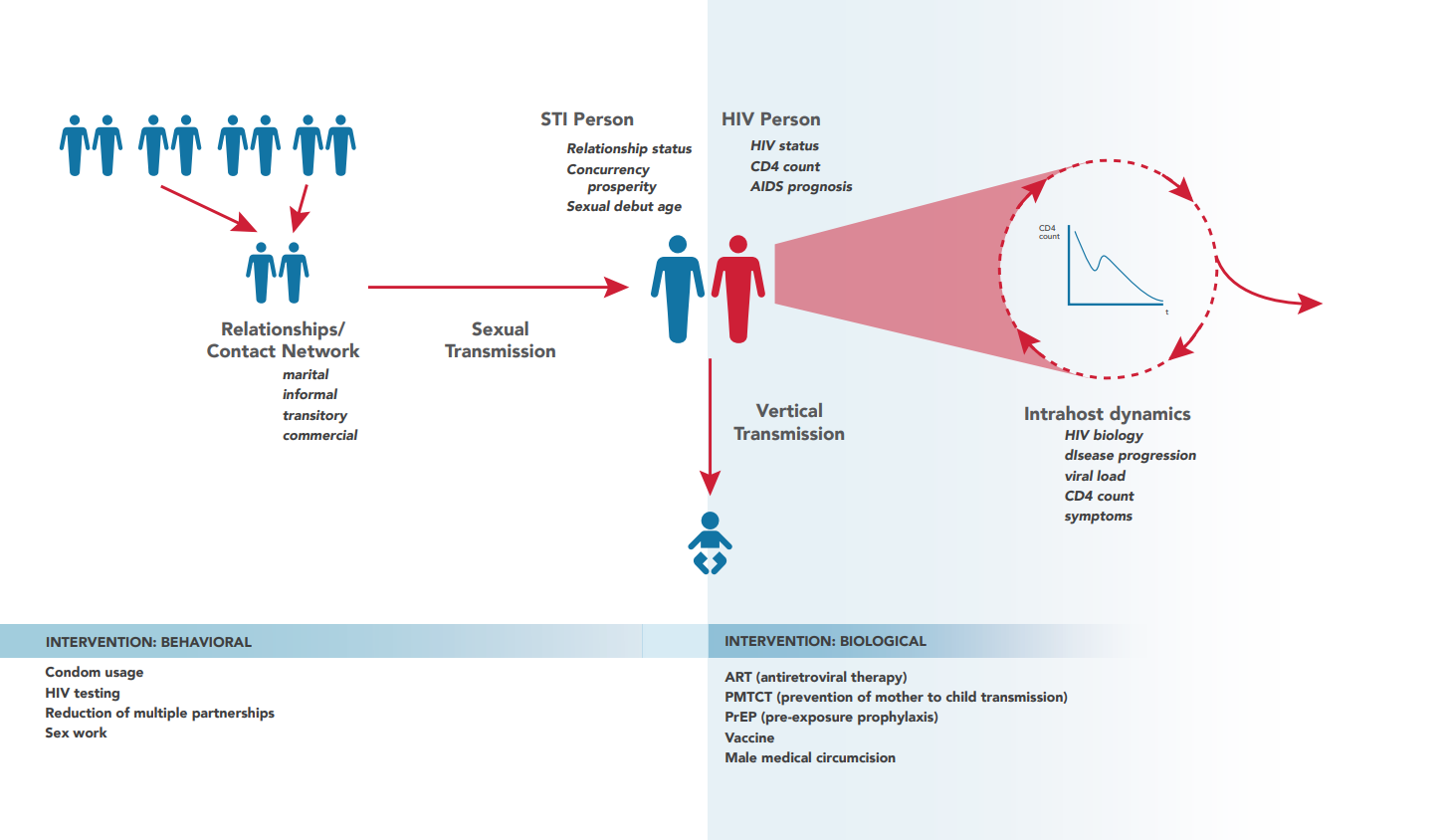HIV model overview¶
The Epidemiological MODeling software (EMOD), HIV model, is an agent-based stochastic simulator of sexual and vertical HIV transmission. It is used to simulate HIV conditions for national-level epidemics in order to evaluate the cost and impact of various treatment and control programs. The model utilizes microsolvers to combine detailed information on contact networks and pair formation, human population dynamics, human immunity, within-host viral dynamics, the effects of antiretroviral drugs, and other aspects of HIV virology to simulate HIV transmission. EMOD can be calibrated to particular geographic locations, and the microsolver framework enables the model’s functionality to be highly modifiable. Further, the framework includes the ability to add intervention campaigns, and those interventions can be specified to target particular populations or sub-populations of human groups. Finally, as an agent-based model, EMOD enables the investigation of various interventions that can be used to interrupt transmission, which can be used to guide policy for implementing practical real-world solutions.
The following pages describe the structure of the model and explore the model components. Additionally, the specifics of the model are discussed in detail in the articles Bershteyn, Klein, Wenger, and Eckhoff, arXiv.org, and Klein, Bershteyn, and Eckhoff, AIDS 2014.
Typical compartmental models are described in Compartmental models and EMOD. The most simplistic method of modeling HIV would be to use an SI compartmental model (described in SI and SIS models). Recall that in an SI model, individuals are born with no immunity; once becoming infectious, there is no resulting immunity gained from the disease and individuals remain in the infectious stage for life. Some HIV modelers increased the complexity of their compartmental models by using an SIR model (described in SIR and SIRS models), but modify the compartments by replacing “Recovered/Removed” with “AIDS,” thereby creating an “SIA” model [Ref29]. Another option for increasing the fit of compartmental models is to add multiple stages of I, allowing for differentiation of the stages of HIV progression. This also enables the addition of ART to the model, where individuals can enter ART at different rates, and then return to survival rates that are similar to HIV- individuals [Ref30].

HIV model framework¶
While EMOD is an agent-based model, individuals move through the infectious states analogously to the compartmental models described above. To account for the real-world complexity of HIV transmission, numerous parameters have been added to EMOD to increase its predictive power. Further, these parameters and their associated microsolvers allow EMOD to model aspects of HIV infections and population dynamics that do not readily fit into the SI framework (for example, the complexities that arise due to relationships and human contact networks). Finally, as an agent- based model, EMOD enables the addition of spatial and temporal properties to the simulation.
The following network diagram breaks down the model into various model components, and illustrates how they interact with one another. The components on the network diagram correspond to the structural components listed below. The following pages will describe in detail the general model functionality and how the structural components function.

Network diagram illustrating the HIV model and its constituent components.¶
See the EMOD parameter reference for a complete description of all configurable parameters for the HIV model.
HIV model structural components¶
The model’s modular framework includes the following components:
Citations¶
- Ref29
Jun-jie, et al, 2010. Dynamic mathematical models of HIV/AIDS transmission in China. Chin Med J. 123(15): 2120-2127. https://www.ncbi.nlm.nih.gov/pmc/articles/PMC5523934/
- Ref30
Williams. 2014. Fitting and projecting HIV epidemics: Data, structure, and parsimony. https://arxiv.org/ftp/arxiv/papers/1412/1412.2788.pdf